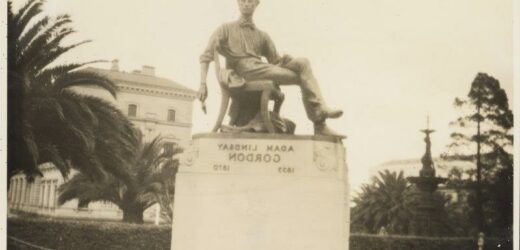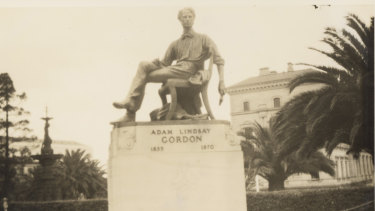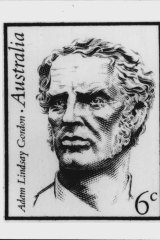On June 24, 1870, the British-Australian poet Adam Lindsay Gordon died in Melbourne. Gordon was also a police officer, politician, and a well regarded horseman. He was the first Australian poet to gain significant recognition abroad, and he is immortalised with a bust in Poets’ Corner, in London’s Westminster Abbey.
First published in The Age on March 20, 1993
Poetry in motion
ADAM Lindsay Gordon sits in Spring Street and from his chair looks across the road to the Windsor Hotel. His face is clean shaven and alert, his nostrils look as if he is sniffing his surroundings, and he uses his fingers as a bookmark in a small volume he carries. He wears corduroy trousers tucked into long wellington boots, and he almost sags in his chair, as if either his body is tired or his legs are too long.
A statue of Adam Lindsay GordonCredit:George W. Nixon. State Library of Victoria
Rarely is anyone seen looking at Gordon’s statue, or the saddle and wide hat tucked under his chair. Rarely is anyone seen stooping to read the verses carved on the stone base. One of the most famous of all Australians at the start of this century, Adam Lindsay Gordon has suffered a remarkable eclipse. It is doubtful that anybody else famous in the arts has so slumped in public favour.
Coming out in the gold rushes of the 1850s, Gordon served as a police trooper in South Australia, briefly sat in its Legislative Council where his few speeches were spiced with Latin, took sheep to the back of Bunbury in Western Australia, ran a livery stable at Ballarat’s flashest hotel, wrote three books of verse which few people bought in his lifetime, and then, in 1870, deliberately shot himself with his rifle in the seashore scrub at Brighton. He was 36.
He was a loner. His wife especially remembered his silences. An editor noted that Gordon was silent on one visit to his newspaper office but on another he would “talk for an hour, generally when I was most busy”. How the sculptor Paul Montford finally portrayed him in bronze in Spring Street, 60 years after Gordon’s suicide, aroused argument.
Sir Arthur Streeton, the painter, thought that the sculptured Gordon showed, for someone so athletic, “a lack of robust strength and breathing space in the region of the chest”.
An ultra-courageous horseman, Gordon had been a dashing steeplechase rider when that form of racing was in vogue, especially in Victoria.
He rode at Flemington with a strange riding action, perhaps a consequence of his lankiness. He was short-sighted and perhaps did not fully realise the risks he ran.
Adam Lindsay Gordon on an Australian stampCredit:The Age Archives
It was primarily as a poet of horsemanship that Gordon began to attract readers and reciters in a land that was horse mad. In the year before his death, he published `How We Beat the Favourite’ in a Melbourne weekly. In the same pages appeared his `Sick Stockrider’, the most popular horse poem in Australia for some third of a century, until `The Man from Snowy River’ slowly rivalled it.
Gordon more than anybody made the wattle blossom a national symbol. He relished the bush flowers and the strange trunk of the eucalpyt. He imagined that the `Sick Stockrider’, in his grave, heard the local children romping overhead as they picked the wild flowers.
Gordon’s poems touched a chord in that generation of Australians who were torn between occasional nostalgia for England and affection for an Australian way of life. His verses were easily remembered. A smoke night or school concert was incomplete without a recitation from Gordon. He wrote those simple lines which, more than any other verses before or after, the typical Australian knew by heart: “Two things stand like stone _ Kindness in another’s trouble _ Courage in your own.” That must be one of the few Australian entries in the `Oxford Dictionary of Quotations’.
After his death, Gordon began to win over English and American critics. In the 1880s, Oscar Wilde offered praise, calling him the poet who gave Australia “her first fine utterance in song”. Kipling, Galsworthy and many others joined in a chorus which culminated in a place of honour being set aside for Gordon at poet’s corner in Westminster Abbey in 1934, with the future George VI presiding on the day of consecration. The statue in Spring Street was unveiled in the same decade.
Those last tributes were just in time. Gordon’s fame was falling like a spent rocket. He was condemned as someone whose heart lay elsewhere at least as much as it lay in Australia. And yet he had been a trailblazer in that long, hard task of making Australians feel emotionally at ease in a land with strange vegetation, light, climate and calendar. Whole generations of Australians had borrowed his horse and saddle but, sadly, forgotten their debt to him.
Most Viewed in National
From our partners
Source: Read Full Article




